Fact:
On May 8, 2019, Taliban insurgents detonated an explosive-laden vehicle and then broke into American NGO Counterpart International’s offices in Kabul. At least seven people were killed and 24 were injured.
Following is the April 2024 installment of “ISIS Redux: The Central Syria Insurgency,” a monthly chronicle of attacks by the terrorist group ISIS in central Syria. All previous 2024 monthly installments can be found here, as well as a review of developments throughout 2023, 2022, and 2021. A full background and analysis of ISIS’s resurgence in Syria, including the methodology used to collect this data, can also be explored here, here, and here.
ISIS carried out at least 42 confirmed attacks in April in the Homs, Hama, Raqqa, and Deir Ez Zor governorates. These attacks killed at least 50 pro-Assad regime soldiers and six civilians and wounded at least 23 more soldiers and civilians. There were also 12 high quality* attacks carried out during the month. The level of violence in April did not approach that of March, but nonetheless qualified as an abnormally active month in the Badia, and there were more attacks and high quality attacks than in both January and February. Notably, April was the first month this year with fewer than 10 civilian deaths. ISIS targeted civilians at a much lower rate compared to previous months, with two thirds of all attacks directed against security forces and nearly all civilian deaths resulting from mines or improvised explosive devices (IEDs). This change likely reflects the truffle season coming to a close and civilians increasingly avoiding entering the desert.
ISIS did not experience as much success in April capturing regime outposts as in March. Still, the group managed to maintain consistent serious operations against the critical Taybeh-Kawm axis while also ambushing regime transports and outposts across Homs, Raqqa, and Deir Ez Zor. Russia also continued its extremely active bombing campaign against both static ISIS targets and in providing close air support during larger ISIS attacks against fixed regime positions. According to journalist Zain al-Abidin, these airstrikes killed at least 15 ISIS fighters during the month, bringing the number of confirmed ISIS deaths in the Badia this year to 61.
Despite these losses, which include the loss of several trucks, ISIS cells maintained an aggressive posture, carrying out 12 high quality attacks, capturing several regime positions, and even using mortars and an anti-tank guided missile (ATGM) in two attacks —an extremely rare occurrence in the Badia. As in March, fewer than one third of all attacks in April relied on mines or IEDs, again indicating a more aggressive ISIS posture. Most mine incidents occurred in southern Raqqa, where ISIS had issued a warning to locals in the beginning of the month not to venture into the countryside or they would be considered “spies” of the regime and targeted.
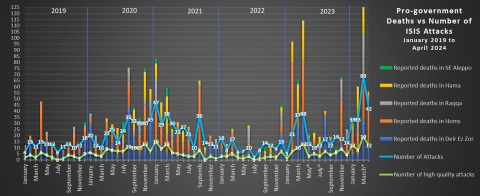
*Indicates attacks in Damascus City claimed by ISIS. Two additional IED attacks occurred in Homs City in June 2023 and Damascus in March 2024 that went unclaimed but were suspected to be conducted by ISIS.
Confirmed ISIS attacks decreased in April in every governorate compared to March. The biggest drops came in Homs (13) and Hama (4), with smaller drops in Deir Ez Zor (13) and Raqqa (12). No attacks were recorded in Aleppo.
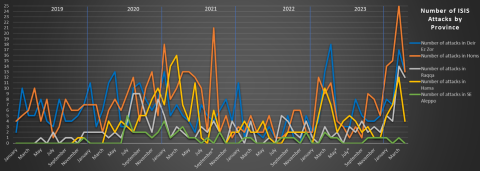
ISIS expanded its low-level insurgency within the urban belt of Deir Ez Zor in January, when it conducted three assassinations of local security members. Sleeper cells continued this trend in February, carrying out two assassinations of local pro-regime fighters inside Mayadin city, and again in March, when unidentified gunmen conducted three attacks inside Mayadin and one attack on the edge of Shamitiyah. This pattern continued into April, with two attacks inside and one adjacent to towns in Deir Ez Zor
On April 3, two civilians were killed by a mine near Harbisha, west of Shoula, while two others were killed by a mine in the countryside north of Deir Ez Zor City. ISIS cells also attacked a regime position in the Tabni countryside, killing one soldier. On April 5, ISIS conducted three attacks in west Deir Ez Zor. First, cells targeted a regime position in a house on the outskirts of Shamitiyah, killing two soldiers from the 17th Division and wounding three others (it is worth noting that in March, ISIS carried out a similarly deadly attack inside this same town, killing a colonel). To the northwest, another ISIS cell attacked the Majbal checkpoint along the highway outside Maadan Atiq, near the border with Raqqa, killing two National Defense Forces (NDF) fighters. Later that evening, a third attack targeted a regime barracks in the countryside outside of Tabni.
On April 8, three local fighters from an Iranian-backed militia were killed when their position was attacked in the Mayadin desert near Muzailiyah. That same day, ISIS fighters attacked and robbed a group of truffle hunters in the west Deir Ez Zor countryside, though they left all alive (presumably because they were women and an elderly man). On April 15, a 17th Division position was attacked in the nearby Dweir desert. ISIS cells returned to Tabni on April 18, targeting another 17th Division position in the countryside outside the town. There were no known casualties from these three attacks.
According to Zain al-Abidin, ISIS conducted another insider attack inside Mayadin on April 26, firing on a military intelligence patrol and wounding one of the officers. Leaflets then appeared in part of the city threatening all locals who work with the regime and Iran. The next day, two Iraqi foreign fighters operating under Iran’s control were killed in an attack in the Mayadin countryside. On April 28, at least one local NDF fighter was killed in an attack in the Masrib countryside in west Deir Ez Zor, near Tabni.
In Raqqa, ISIS’s low-level but significant insurgency escalated in March and has continued since then, focused around Maadan and the Resafa countryside. As in March, most of the mine or IED incidents in April occurred in Raqqa. On April 3, two mine incidents occurred in the Maadan countryside, one damaging a tractor in a field and the second killing a civilian and wounding another. On April 7, a woman was wounded by a mine while truffle hunting outside Maadan, while that same day an ISIS cell fired mortars at a Liwa al-Quds position in the area. This was the first ISIS mortar attack since October 23, 2023, when mortars landed outside Sukhnah. On April 8, two more mine incidents occurred in the Maadan desert, leaving one civilian dead and two wounded. On April 14, a woman was wounded by a mine outside Ghanem Ali, west of Maadan.
On April 17, an ISIS cell attacked an oil convoy on the Tabqa-Ithriya road in southwest Raqqa, damaging some of the vehicles. The next day, a local NDF member was wounded by a mine outside Resafa. On April 23, a civilian was wounded by a mine outside Sabkha, near Maadan. And on April 27, ISIS cells conducted two attacks against regime positions in Raqqa. The first targeted a regime position south of Tabqa, leaving three soldiers dead and four wounded during a protracted battle that included the deployment of regime reinforcements and Russian airstrikes. The second occurred near Bir Rahum, south of Resafa, resulting in an unknown number of casualties.
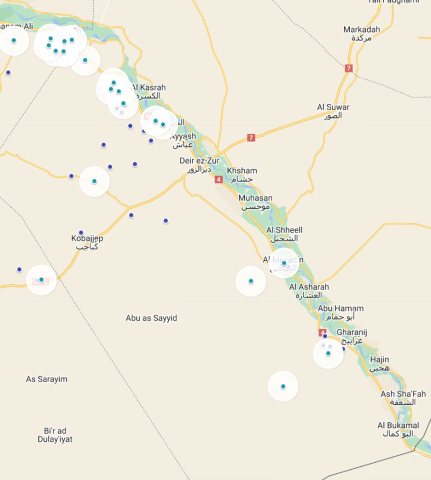
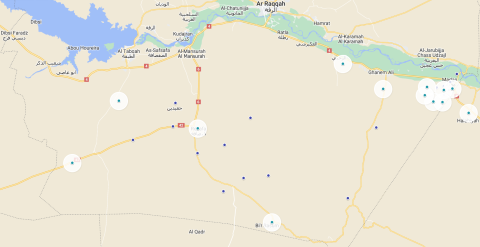
Map of locatable ISIS attacks (highlighted) in Deir Ez Zor (top) and Raqqa (bottom) in April 2024 alongside all other attacks in 2024.
Homs
ISIS activity in eastern Homs decreased in December, but remained focused around the Doubayat Oil Field, which the group had temporarily captured in November. January likewise saw most ISIS activity concentrated in this area, though the group also expanded operations west into the desert just south of Palmyra and Arak. In February, ISIS largely abandoned the southern Palmyra front, likely because of pro-regime ground and air operations, and shifted its focus to the Taybeh sector north of Sukhnah and the Jubb Jarah mountains north of Palmyra. This focus continued into March, with activity remaining concentrated in the Sukhnah-Taybeh-Kawm axis in April. However, security forces continued to largely stand their ground.
On April 1, ISIS ambushed a truck carrying 18th Division soldiers southeast of the T3 Station, killing five. The next day, local Facebook pages reported the disappearance of a civilian from Palmyra who had been truffle hunting near Taybeh. On April 7, ISIS cells conducted two large attacks, one targeting regime positions west of Sukhnah, in which at least one soldier was killed, and the other north of Kawm. According to Zain al-Abidin, Russian jets were called in to hit the attackers near Kawm as well as suspected ISIS positions south of Sukhnah near Doubayat.
On April 14, local Facebook pages reported the theft of 150 sheep from shepherds outside the village of Jabab Hamad, south of Jubb Jarah and just 30 miles outside of Homs City. The next day, ISIS cells again targeted military vehicles east of the T3 Station, this time shooting at trucks belonging to the Iranian-led Afghan Fatemiyoun. On April 18, ISIS captured a checkpoint east of Sukhnah, looting it before withdrawing. The biggest attack of the month occurred on the same day, when ISIS fighters ambushed a truck loaded with Liwa al-Quds fighters traveling between Kawm and Taybeh. The attack killed all 21 of the militiamen, and ISIS later claimed responsibility and published a picture of the immediate aftermath. On April 21, three Military Intelligence soldiers were ambushed and killed while also traveling near Taybeh as part of the regime reinforcements sent to that front.
The next day, ISIS militants target the T3 Station itself, which has been defended by tanks from the 4th Division since late March. On April 24, ISIS members fired on a regime truck with an ATGM just two miles east of Sukhnah, though they missed the vehicle. This was the seventh documented ATGM attack in the Badia since the ISIS insurgency began, the others occurring in 2019 (2), 2020 (1), 2021 (1), and 2022 (2). On April 26, ISIS again carried out two large attacks in Kawm and Sukhnah. One resulted in the capture and looting of two regime positions west of Sukhnah while the other, involving a large group of militants, resulted in the deaths of at least two Afghan foreign fighters in Kawm and the intervention of Russian jets, according to reporter Zain al-Abidin.
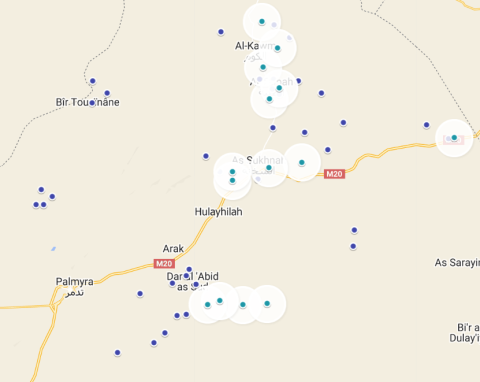
Map of locatable ISIS attacks in Homs (highlighted) in April 2024 alongside all other attacks in 2024.
Hama
Significant ISIS activity returned to east Hama in January, when the group conducted five attacks in the province, three of which were deemed high quality. Likewise, ISIS conducted three high quality attacks in eastern Hama in February. This was the first time eastern Hama had back-to-back months of three or more high quality attacks since spring of 2021, amid the regime’s semi-successful campaign to suppress ISIS activity in the province. March continued this trend with five high quality and 12 total attacks, almost all against security forces. However, activity reduced significantly in April, with only four confirmed attacks all month.
On April 1, the bodies of four local men, all from the same family and serving in the NDF were found east of Tel Salamah. On April 6, a soldier was wounded in clashes near Tanahij. On April 11, a young teenager was wounded by a mine while tending to sheep in the Sa’an district and on April 16, a young girl was wounded by a mine outside her town of Soha.
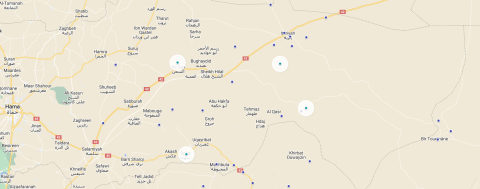
Map of locatable ISIS attacks in Hama (highlighted) in April 2024 alongside all other attacks in 2024.
Looking Ahead
The reduction of ISIS activity in April compared to March should not be taken as a sign that the group is now on its backfoot in the Badia. As this author said in last month’s report, what we saw in March was unprecedented and would not continue into April. However, that does not mean March was a total aberration. What we are witnessing is a clear, six months and counting trend of elevated ISIS activity in the Badia.
It remains deeply concerning that ISIS cells have been able to maintain such a high degree of activity nearly unabated since October 2023, despite multiple regime operations that either stunted or pushed back ISIS’s offensives. During this period, ISIS has demonstrated a clear ability to adapt to the regime’s defenses, moving significant manpower and resources to new fronts and apparently withstanding a low but sustained degree of attrition from Russian airstrikes. Again, it must be emphasized that all signs point to ISIS having successfully replenished at least some of its manpower and equipment over the past two years.
All of this ISIS activity is occurring simultaneously with ISIS’s equally elevated and sustained degree of activity in northeast Syria. As analyst Charles Lister reported last month, “According to SDF authorities, there were 30-40% increases consecutively each month from January, more than 115 attacks recorded in total,” nearly matching the 135 attacks conducted in the Badia during that time. Never before has ISIS carried out such a significant and simultaneous surge in attacks in both central and northeast Syria. It is unclear how effective the Syrian Democratic Forces (SDF) and the Coalition’s counter-ISIS activities have been of late. According to a Coalition announcement on April 22, the SDF has only conducted 28 counter-ISIS operations during the first three and a half months of the year, resulting in 27 detained and seven killed ISIS members. However, 16 militants were detained in just one of these operations, calling into question the success of the majority of the 28 operations. All of this points to the worrying possibility that the SDF and Coalition are now struggling to uncover and remove ISIS networks in the northeast faster than they are being created.
It remains unclear how long ISIS will sustain this level of activity in both central and northeast Syria. History suggests the group will have to reduce attacks at some point in order to rest, refit, and recover. However, as it currently stands, it seems that the most pressing question is whether Russia will be able to sustain its current high level of air support longer than ISIS can continue conducting large attacks against key regime positions. ISIS may be attempting to outlast this airpower, hoping that it can absorb losses long enough for the Russians to ease off, opening a hole in the defenses around Kawm or Taybeh.
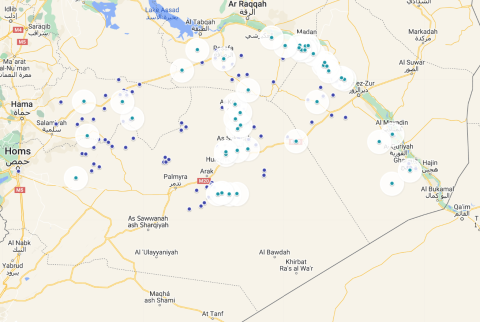
Map of locatable ISIS attacks (highlighted) in April 2024 alongside all other attacks in 2024. To view an interactive version of this map, please click here.
*High quality attacks are defined as attacks behind frontlines, those that result in seized positions, target regime officers, involve coordinated attacks on multiple positions, fake checkpoints, ambushes on military convoys, or attacks on checkpoints that kill at least three soldiers or lead to POWs.
Extremists: Their Words. Their Actions.
Fact:
On May 8, 2019, Taliban insurgents detonated an explosive-laden vehicle and then broke into American NGO Counterpart International’s offices in Kabul. At least seven people were killed and 24 were injured.
Get the latest news on extremism and counter-extremism delivered to your inbox.